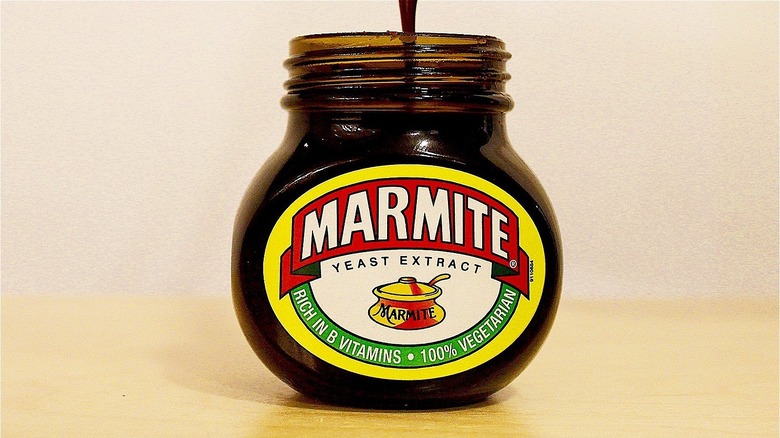The Accidental Origins Of Marmite
Marmite is a pretty controversial product, with half of the world loving it and the other half despising it. According to The Guardian, the extremely unique taste of Marmite can be described as having a thick, syrup-like texture with a salty and yeasty profile that's similar to soy sauce and other umami flavors. Marmite has become an integral part of British culture, so much so that there was actually a £15,000 statue of a jar of Marmite constructed in Burton-on-Trent, which is where Marmite was invented, per BBC.
While Marmite is typically enjoyed spread on a piece of toast, many chefs use the spread for exquisite dishes, such as Marmite toast topped with a cured egg yolk, steak tartare, and bone marrow drippings or scallops with crispy chicken skin, black truffles, and an au jus made with Marmite, elderflower vinegar, and soy (via The Guardian). Since its creation, Marmite has expanded beyond the jar and can also be enjoyed (or despised) in rice cakes, cashew nuts, crisps, and cheddar bites. Interestingly, some claim that Marmite can also be used to protect against mosquitos.
Marmite has a long history and was actually invented by accident. Here's the origin story behind Marmite.
Marmite was invented in the 19th century
According to the BBC, Marmite was accidentally invented by Justus Liebig, a German scientist, in the 19th century. He found that the concentrated yeast extract that was left over from the beer brewing process was actually edible, per Marmite. So, Liebig created the Marmite Food Company in 1902 in Burton-on-Trent, Staffordshire, United Kingdom, and made a Marmite recipe that included the yeast concentration, celery, salt, and various spices (via BBC). Liebig chose to build his Marmite factory in Burton-on-Trent, Staffordshire because he has easy access to the required Marmite ingredients from the various breweries around the town. Eventually, Liebig added vitamin B12, folic acid, riboflavin, and thiamin to Marmite.
Liebig's addition of various nutrients to Marmite caught the attention of two biochemists in 1912 who had their own theory about vitamin deficiencies being the reason for various diseases and thought that Marmite was the perfect solution. Marmite was then used to feed schoolchildren, people in hospitals, and even soldiers who fought in World War I and prisoners of war during World War II.
Interestingly, Marmite was originally sold in small terracotta pots that were inspired by a specific casserole dish from France that's also called Marmite, according to the Museum of Brands. While the product is now sold in glass jars and has been since the 1920s, the original earthenware pot that Marmite used to be sold in is pictured on the front label, reminding consumers of Marmite's history.

